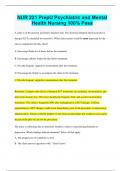Exam (elaborations)
NUR 221 PrepU Psychiatric and Mental Health Nursing 100% Pass
- Course
- Institution
NUR 221 PrepU Psychiatric and Mental Health Nursing 100% Pass A client is in the geriatric psychiatry inpatient unit. The client has bilateral electroconvulsive therapy (ECT) scheduled for tomorrow. Which intervention would be most important for the nurse to implement for this client? A. E...
[Show more]



